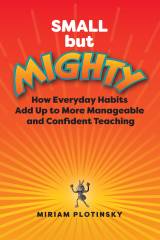from Small but mighty: How daily habits contribute to more manageable and confident teaching (pp. 78-80), by M. Plotinsky, 2024, ASCD. Copyright 2024 by ASCD. Reprinted with permission.
In the past few years, formative approaches have gained considerable popularity as the preferred method of assessment, largely due to the ideology behind the practice. Not too long ago, students were taught material in classrooms, primarily through direct stand-up and delivery instruction, and were subsequently asked to demonstrate their learning in what is now called summative or “high-stakes” assessment. In this model, it wasn’t just the grades that were cast in stone once the test scores came in; there was also an assumption that students knew the material well enough to move forward with new concepts and that anyone who fell behind must either catch up or succumb to a prolonged (perhaps constant) struggle.
 This sink-or-swim approach to education has fallen out of favor over time, especially as a result of increased awareness of equity-led learning and the implications for teaching and learning during the pandemic. Turning a blind eye to student struggle is harmful, as is closing opportunities for growth. Furthermore, the idea of determining student achievement within a given content standard only at the end of a unit is fundamentally untenable. Ideally, teachers clarify confusion and check for understanding continuously throughout the unit.
This sink-or-swim approach to education has fallen out of favor over time, especially as a result of increased awareness of equity-led learning and the implications for teaching and learning during the pandemic. Turning a blind eye to student struggle is harmful, as is closing opportunities for growth. Furthermore, the idea of determining student achievement within a given content standard only at the end of a unit is fundamentally untenable. Ideally, teachers clarify confusion and check for understanding continuously throughout the unit.
The pushback that leaders often face when asking teachers to formally assess students more often centers around defenses around two rare commodities: time and bandwidth. How, teachers ask, can they assess students with any frequency when the instructional period is short, when assessments are cumulative, and when district leaders do not provide additional time for planning or preparation?
The answer to a complex question can be startlingly simple, and that is true in this case. Rather than thinking of formative assessment as a continuous process, it helps to focus on using tools that will tell us what we need to know quickly. The following assessment bank shares some proven methods for quickly gathering information about what students know and can do. Students may be asked to do any of the following:
- Take a short survey (one or two questions).
- Summarize the day’s learning objective in one sentence.
- Complete an exit or entry ticket that shares a concept or is an open-ended question.
- Hold color-coded cards (often red, yellow, and green to match the traffic light) to indicate level of understanding or confusion.
- Reflect briefly (3-5 sentences) on a given concept.
- Complete the stem of the sentence: “I still don’t understand. . . .”
- Put questions that do not need immediate attention in a general “parking lot”.
- Put “Hot Questions” on the board to clear up more immediate confusion.
- Draw an important concept instead of writing about it.
- Take new learning and apply it to a different situation.
- Create a short assessment for peers to complete.
- Write a short summary of the training in social media style.
- Make a “mic drop” statement that leaves everyone with a final thought for the day, verbally or in writing.
When students do short assessment activities like these, they focus more clearly on the outcome of whatever they’ve learned, and their progress is also more visible. Shorter comprehension checks do not negate the need for longer, summative tests that show what students have learned by the end of a unit or period of study. However, when teachers tire of giving one long assessment after another with questionable benefits, adopting a regular habit of using quick forms removes a great deal of stress and reveals valuable data that moves everyone in the classroom forward.

